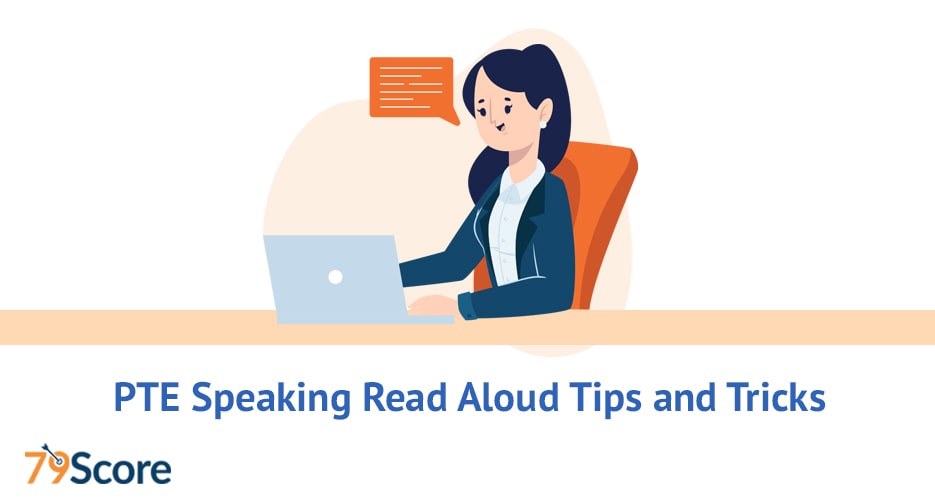PTE read aloud question type comes first in the exam for the speaking section. Looking at the question prompt type, all students feel easy at first. But, when it comes to the exam day it brings down your confidence when unfamiliar words are put to pronounce. In this guide we will provide you PTE Read Aloud tips and tricks.
First, let’s see what PTE read aloud question type demands on the exam day:
You will get 30-40 seconds to prepare before the recording starts. Once the beep sound is played, you can start reading the passage loud and clear. Remember don’t start speaking before the beep sound is played, as your voice will not get recorded.
Before the progress bar of the recording ends, finish reading the passage. Otherwise, the microphone will stop recording from that point of time, even if you have not finished reading the whole passage.
Do remember, if the computer detects silence for more than 3 seconds, the recorder will stop recording the voice and you will lose marks for the rest of the paragraph.
Now let’s look at the scoring guidelines for PTE read aloud:
PTE Read Aloud Tips to Improve score in the PTE exam
During the preparation time of 30-40 seconds, prepare yourself by mocking the answer. Try to read aloud the paragraph as if you are giving the real answer. Try to practice the words which seem new or difficult for you to pronounce. This will prepare your brain for pronouncing the most difficult words before the recorder starts.
The other task you can do before the recorder starts is to divide the paragraph into a meaningful chunk to improve your oral fluency in PTE read-aloud section. Taking the necessary pause will give proper meaning to the whole paragraph, which will improve your enabling skills. Look at the following example where the sentence is divided (/) into proper chunks to give it meaning:
Yellow is the most optimistic color, /yet surprisingly, /people lose their tempers most often in yellow rooms /and babies cry more in them./ The reason may be that yellow is the hardest color on the eye. /On the other hand,/ it speeds metabolism and enhances concentration; /think of yellow legal pads and post-it notes.
Focus on punctuation such as commas, semi-colon, and full stops; ignoring this will make your oral fluency suffer.
Intonation, which is also a key factor for scoring high in the PTE read-aloud section. When you read the text, stress the words that help to convey meaning, by reading them in a slightly louder voice and adding emphasis to key syllables.
To practice intonation, try to pretend as if you are reading the news in the Primetime show at 8 and imitate with your hand movement. This will help your brain to read it more naturally and to convey the meaning. However, you can also stand in front of the mirror to improve the intonation and read-aloud score. The above techniques to improve PTE read aloud can be implemented in 79score.com’s mock test and practice test to check the level of your performance.
Be confident, loud, and clear enough for a computer to recognize your voice. To be confident, try to read the newspaper daily in front of the mirror as if you are trying to convey the message to a larger audience. These PTE Read Aloud tips will help you to overcome your nervousness before speaking any answer.

PTE Speaking read aloud is scored based on three factors.
- Content: Have you included all the words as per the given passage? The addition and removal of the extra word will negatively impact your score. So, try to read the passage as it is in the question. You are given a maximum of 5 marks for the content.
- Oral Fluency: Your ability to speak in a fluent tone without hesitating or taking a long pause will determine your Oral fluency score. Repetition and hesitating will lower your scores.
- Pronunciation: Are you able to demonstrate the proper speech sound as the normal speaker of the language? It is determined if your speech is easily understandable by most of the regular speakers.
Do Try the PTE mock test to check your Content, Oral Fluency, and Pronunciation scores, where you will get a detailed analysis of your scores for the Speaking section.
In PTE read aloud your communicative and enabling skills are scored. The other section which is been partially scored is your PTE Reading, Speaking, Oral Fluency, Pronunciation, and Content.
DO’s and Don’ts for the PTE exam:
Do’s:
- Try to mock the answer before the recorder starts.
- Repeat and pronounce the difficult words during the count-down timer.
- Divide the text into meaningful chunks.
- Read at a normal pace with full confidence.
Don’ts:
- Don’t hesitate or repeat the sentence.
- Don’t add the extra words or letters apart from the original text.
- Try to eliminate the ‘Umming and Urring’ while speaking.
- Ignore the mistakes and keep on reading the next word.
- Don’t be silent more than 3 seconds
Below are some samples of PTE read-aloud for practice purposes. Try to implement all of the above PTE Read Aloud tips to excel in the PTE speaking score, as this carries heavyweight.
- Lincoln’s radical change of mind about his war power to emancipate slaves was caused by the escalating scope of the war, which convinced him that any measure to weaken the Confederacy and strengthen the Union war effort was justifiable as a military necessity.
- Karl Marx is arguably the most famous political philosopher of all time, but he was also one of the great foreign correspondents of the nineteenth century. During his eleven years writing for the New York Tribune – their collaboration began in 1852 – Marx tackled an abundance of topics, from issues of class and the state of world affairs.
- One of the most encouraging phenomena in recent years has been the development of lifelong learning in the education sector. Nowadays, students are embarking on courses of all ages. Higher education is no longer viewed as a place for the young. Mature students are appreciated and respected. Recent research has also indicated that older students are dedicated, learners.
The PTE Mock Tests at Gurully are designed in an almost similar manner to that of the real test. And you can have a test-like experience to improve your speaking as well as reading scores. You can also choose the PTE practice test to target individual sections to improve the overall score.
Remember, read aloud is critical for that dream score on your PTE scorecard. Thus, make a study plan, start practicing with the scored PTE mock test, and evaluate your performance to work on the weak areas.
Frequently Asked Questions for PTE speaking Read aloud
- How can I improve my read aloud skills?
- Practice regularly with diverse texts.
- Focus on pronunciation, pacing, and intonation.
- Record and listen to your readings to identify areas for improvement.
- Use tools like speech-to-text software to check clarity and pronunciation..
- How can I get a high score in PTE read aloud?
- Understand the scoring criteria: content, oral fluency, and pronunciation.
- Practice reading aloud with time constraints similar to the exam.
- Work on clear articulation and natural speech rhythm.
- Familiarize yourself with a wide range of vocabulary and pronunciation.
- How can I improve my read aloud PTE fluency?
- Regularly practice reading different types of texts aloud.
- Focus on maintaining a steady, natural pace without rushing.
- Use punctuation marks as guides for natural pauses.
- Practice breathing techniques to maintain steady speech flow.
- How do you read aloud like a pro?
- Engage with the text: Understand the content and convey its emotion and tone.
- Work on voice modulation to add interest to your reading.
- Practice sight reading to improve your ability to read unfamiliar text smoothly.
- Ensure good posture and breathing for better voice projection.
- What are the 5 important benefits of reading aloud?
- Improves pronunciation and diction.
- Enhances comprehension and retention of information.
- Builds better listening and speaking skills.
- Increases vocabulary and understanding of sentence structure.
- Boosts confidence in public speaking and presentation skills.
- Why do I struggle to read out loud?
- Common reasons include lack of practice, nervousness, difficulty with pronunciation or fluency, and lack of familiarity with the text.
- Dyslexia or other learning difficulties can also impact reading aloud skills.
- Why do I score low for PTE speaking?
- Possible reasons could be issues with pronunciation, fluency, hesitation, lack of content relevance, or not following the test format properly.
- It’s important to review your test feedback and identify specific areas to improve.
- How is read aloud score calculated?
- PTE Read Aloud scores are based on three factors: Content (accuracy in reading the text), Oral Fluency (smooth, natural pace and rhythm), and Pronunciation (clear and correct speech sounds).
- Each aspect is scored based on how closely your performance aligns with native-like usage.
- How to score 90 in PTE speaking?
- Achieving a score of 90 requires near-native command of English.
- Practice extensively with a focus on perfecting pronunciation, fluency, and intonation.
- Use high-quality practice materials and consider professional coaching for targeted improvement.
- Engage in activities that improve overall English proficiency, like extensive reading, listening, and speaking in diverse contexts.
You may like this article: Mistakes to avoid in PTE speaking section to get higher scores
|
79Score
|





